Special Feature: Products Sally Recommends
From Chiang Rai to Tachilek: Off the Beaten Track in Thailand's Golden Triangle
Every now and then an opportunity will arise to see more than what is shown to the average tourist, and when that happens I find such opportunities irresistible. I had read many books about the early days of the Golden Triangle and the amazing and unruly times that this part of the world experienced between the end of World War II and today, when tourists are both safe and welcome on the Thai side of the border with Burma.
Thailand has done an amazing job of rehabilitating and developing their part of this corner of Asia, and even the current economic meltdown that some South-East Asian countries are experiencing should not necessarily deter the visitor wanting to see this fascinating part of the world. While enjoying the northern-most parts of Thailand with its misty mountainous beauty, the wanderer in me could not resist a chance to journey into Thailand’s neighbor Myanmar, formally called Burma, and still referred to as such by most people today.
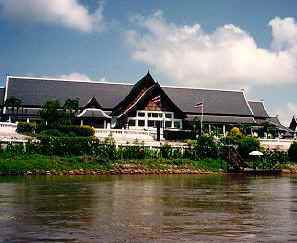
We were staying in the beautiful Thai-architecture Rimkok Hotel Resort overlooking the Mae Kok River that flows past Chiang Rai, the northernmost major town in Thailand. Sitting in the lobby I had been pleased to re-establish contact with one of the staff who I had last met when he was with the Phuket Yacht Club hotel down on the coast. The conversation drifted to what was happening in Burma, which I had visited on a trip to Yangon and Mandalay and had found fascinating.
"It’s a different world altogether in this corner of that country," my friend Bee (his real Thai name is such a tongue-twister that foreigners call him by this abbreviated nickname) had told us."
"This part of the country was only nominally Burmese. The real rulers until very recently were the Opium Generals who were little more than warlords. Now the Burmese Generals seem to have taken over and done some sort of a deal that none of us can really understand. The fact is that the opium is still being grown and all the international laws and agreements are still being flouted. It’s a very murky situation."
Bee went on to explain that on the Thai side of the border the Government had really cleaned up the bad old systems and habits. But when it came to the Myanmar (Burmese) side, it was another story. There nothing was clear-cut, and the bad old ways that defied just about everything that modern countries were trying to achieve, were still more the norm than the exception.
When I hear stories like that I can never resist the urge to check them out. Would it be possible to cross over and see for myself? "Sure," said Bee, "I’d be happy to help organize a trip for you. But there is always a slight risk involved. If you get into any difficulties -- though that’s unlikely -- there’s no-one who can help you."
I had thought out the pros and cons, assessed the risks as I knew them, and decided to take a chance. Would Bee organize a guide and transportation? The next morning it was all set up. The stage had been set.
The next morning finds Bee and ourselves in a 4-WD on the road heading for the Thai-Burmese border-town of Mae Sai. The road takes us past concentrations of apartments, stores and workshops.
As we approach the border crossing we see an ever-optimistic flotilla of pedi-cabs lined up at the end of the road waiting for customers. And also waiting for tourists is a gaggle of Thai children, dressed in colorful hill-tribe costumes, and cajoling money in exchange for posing for photographs. "They’re not really from the hill-tribes," Bee informs us. "They’re local children whose family have bought them these costumes to try and make a quick dollar."
The border point between the two countries is actually the middle of the bridge that straddles the polluted-looking brown river making its slow way down a gully beneath us. Two barriers made from iron piping carried a sign that reads "Welcome to Myanmar".
We approach a makeshift hut in which two lethargic soldiers slouch in their chairs, deeply engrossed in conversation. Five minutes later they are finished and now charge us just US$10 for a one-day border-pass into the People’s Republic of Myanmar. Bee mutters that this will be sufficient time to explore the small border town called Tachilek, lying a short walk from the river.
As I hand over the money, I can’t help thinking about the irony of the People’s Republic of Myanmar only accepting U.S. dollars, a currency, which until recently was much hated, no doubt for ideological reasons. But hard currency is hard currency, and with the devaluation of the Thai Baht, the Burmese know what money has the best international standing.
Next we are asked to hand our passports in to the border guards. We do so with great reluctance in spite of assurances from Bee that everything will be all right. That, in the event, turns out to be quite correct.
After the modernity and style of Thailand, Myanmar comes as a bit of a shock. It is hard to pinpoint what is different, though I realize that the people here look considerably poorer than their Thai counterparts. This is possibly because the chances to earn money are less here than in the Western-style economic system prevailing in Thailand.
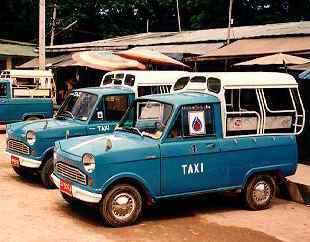
Here in Burma one sees very few cars and much of the transport is by trishaw. The half-dozen taxis powered by tiny Mazda motors that we see in the village, are really just primitive pick-up trucks. They have benches at the back of their trays on which the passengers sit. All are colored light blue, and I wonder if the only paint factory in Myanmar produces no other color.
Then into the market where we are surprised to see that many of the stall-holders are not locals, but Bangladeshis who are selling merchandise that is predominantly from China. Everything from cigarettes to whisky carries the ‘Made in China’ label. No prize for guessing who controls the economy here.
As we moved down the line of shop-stalls, looking at the Chinese products for sale, we suddenly stop in our tracks. There it is, hanging on the corrugated iron wall. Our first sight of a tiger skin.
Moving further down the road we now see more street stalls, each with up to 20 or so tiger and leopard skins hanging up for sale. Others display these skins folded, lying in glass counters along with hand-carved tiger fangs and pairs of Indian elephant tusks. There are also monkey skulls, and some dried, brown sacs that look like small deflated balloons. All these items contravene the International Convention referring to Endangered Species.
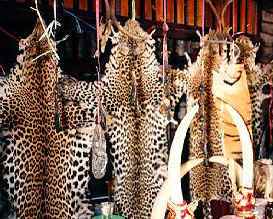 As I look, I am reminded of the official figures on tiger-survival numbers which indicate they are sliding into extinction. In 1994 there were believed to be only 150 to 200 Siberian tigers, three to four thousand Bengal tigers and 650 Sumatran tigers left in the world. And now right here in front us are dozens of stalls loaded up with literally hundreds of tiger and snow-leopard skins -- just in this tiny border village alone! It is very depressing. Thank God I’m not a tiger! My career path -- and life span -- would be very limited indeed if I were one of these magnificent beasts in Myanmar.
As I look, I am reminded of the official figures on tiger-survival numbers which indicate they are sliding into extinction. In 1994 there were believed to be only 150 to 200 Siberian tigers, three to four thousand Bengal tigers and 650 Sumatran tigers left in the world. And now right here in front us are dozens of stalls loaded up with literally hundreds of tiger and snow-leopard skins -- just in this tiny border village alone! It is very depressing. Thank God I’m not a tiger! My career path -- and life span -- would be very limited indeed if I were one of these magnificent beasts in Myanmar.
Next we see bits of dried animal tissue --- some that look like small, dark brown, deflated balloons and others that vaguely resemble small, dark-yellow mountain-goat horns. They intrigue me and I ask Bee what they are. "Dried bear gall-bladders and dried tiger penises," he explains. "They are quite expensive here, but cost only a fraction of what they would bring in Bangkok, Singapore or Hong Kong. People in Asia will pay anything for these, because they consider them to be great aphrodisiacs and also a cure for all kinds of sickness."
One of the English-speaking stall holders tells me that the carved tiger fangs I am looking at cost 300 Baht each, and the bear gall-bladders 1,000 Baht. Local tiger skins start at 3,600 Baht and large leopard skins at 9,000 Baht. The very large fully-grown Indian tiger skins, golden-brown with black stripes and in perfect condition, sell for 30,000 Baht (US$1 = 45 Baht).
He goes on to tell us that the tiger penises and bear gall bladders are first air-dried, and can be bought in that state. "But most people here who cannot afford to buy these expensive ingredients, settle for a cocktail." He points to a square jar on the counter. It is filled with a dark-brown alcohol in which the tiger penises and bear gall bladders have been "marinated."
We notice that almost every shop has a jar of this reputed potent potion on the counter. From time to time a customer appears to buy a small glass of the "Burma Cocktail". The liquid is poured into a glass, the customer drinks it straight down as if it were vodka, and the shopkeeper then tops up the container and is ready for the next customer.
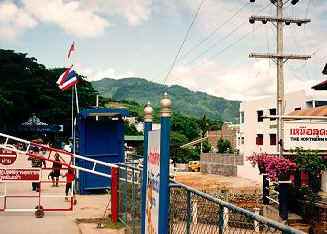
It is with heavy hearts that we head back to our hotel, leaving Myanmar across the same bridge by which we entered, past the same children begging us to take their pictures. It’s all so easy to condemn these people for killing these beautiful wild animals. But who are we to judge when we don’t know the pressures of life they are under or the theories and beliefs that make them act the way they do.
One of the big problems I always see with the way we are programmed to think and act in a well-educated Western environment, is that we rarely ask ourselves how we would react if we were brought up among the ingrained beliefs, poverty and superstitions that so affect the lives of people in third-world countries.
The Animist Fertility Temples of Thailand
A few days later we change hotels and are now staying at the magnificent new Baan Boran Meridien, a hotel built at the very epicenter of the Golden Triangle. Our bedroom window looks out onto the Mekong River and across to Laos, while the view from the hotel’s pool reveals that the property actually butts onto Myanmar as well.
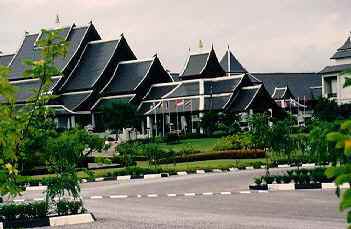
Making friends with locals is critical for a travel writer. Only that way can one really get to know the inside story on what one sees, and have the customs, beliefs and habits of the area explained to you in depth. At this hotel I have also been fortunate to meet an old Thai friend now living in the Golden Triangle. He introduces me to Sahneh, a local driver who speaks very good English and has agreed to show us around this part of the world.
I have read much about the interplay between the Buddhist religion and Animism, and ask Sahneh if, on our next day’s sightseeing, we can have a look at the local fertility temples I had read about.
I had only once ever seen one of these -- in the garden grounds of the Nai Lert Hilton Hotel in Bangkok. Thais are both Animist and Buddhist and the spirit-shrine called Chao Mae Tuptim was dedicated to the Goddess Tuptim. Any woman who was wishing to conceive a child but having difficulty in doing so would pay homage to this goddess in the hope of becoming pregnant.
If she was successful, the mother-to-be might present a gift or wooden penis effigy to the temple. We had seen some that were eight feet tall, others that were much shorter and yet more that were right down to life-size. I remembered how surprised I had been to stumble on these in such an incongruous setting. But that is the charm of Thailand. Why change age-old religious customs just because ‘Farangs’ might find them strange?
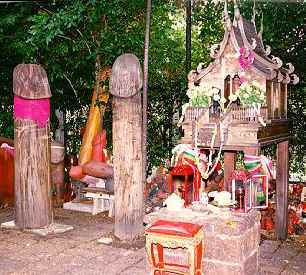
But I had heard of one in this area and now want to see it. As a result of this request, we stop at a modern-looking temple on the top of a hill around which a series of circles of marble steps are surrounded by rings of stylized phallic marble symbols, adorned in some cases with ribbons of gaily-colored cloth that happy women have donated here instead of leaving wooden penises as their cousins do at the Bangkok temple. Judging by the number of colorful cloths tied around the marble symbols, the prayers here worked very well indeed!
As we return to the hotel, our guide points out another fertility shrine called Doi Nang Kew, located on the Chiang Mai road outside Chiang Rai. Here locals toot their car-horns in greeting to the spirit of Nang Kaeo, the district’s Animist Female Spirit whose statue sits in a shrine along the roadside.
Devout Buddhists wish to put a stop to this practice and have erected a large statue of the Buddha in the hope that women who bring phallic symbols to the shrine might pray to Buddha instead. But old habits die hard, and around the back of the Buddha statue I found innumerable phallic representations left as gifts by happy pregnant women, or as supplications from those wishing to conceive.
![]()
Getting there:
Thai International is an outstanding airline that will fly you to Bangkok and then on to Chiang Mai or Chiang Rai. There are now several 5-star resorts in this area, which is a safe and comfortable destination. Going over the border into Myanmar unofficially is not recommended for the average tourist as it does carry some risks, especially as the Myanmar Army rather than the Opium Generals is now in control. To go across to Tachilek in Burma can be arranged through most hotels and travel agents in the area. Take your passports and US dollar notes.
When to go:
Around Christmas is an excellent time of the year. The weather is not too hot and the monsoons have not yet started.
Take:
Plenty of any medication you may require, bring plenty of duty-free film and loose, comfortable cotton clothing.
![]()
Walter & Cherie Glaser are an international travel-writing team based down under in Melbourne, Australia.
Note: This information was accurate when it was published. Please be sure to confirm all rates and details directly with the businesses in question before making your plans.



